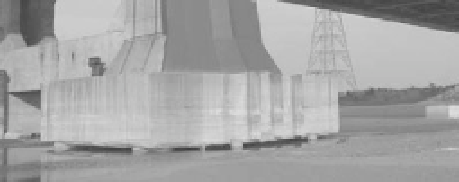Environmental Engineering Reference
In-Depth Information
dynamics of species. The length of gaps between the gravel bars along the Isar River was 80 to 100 m in
1925, but 100 to 1,500 m in 1985. As a result, a grasshopper species is endangered due to a lack of large
gravel bars and the large gaps between bars.
With increased shear stress, the incised reach may become armored as smaller, more mobile gravel is
exported downstream, leaving only larger, less mobile particles in the reach (Livesey, 1965). One
consequence is the loss of spawning habitat for fish such as the Alosa fallax in the upper Garonne River,
sturgeon in the lower Garonne (Beaudelin, 1989), and chinoot salmon in the Sacramento River in
California (Parfitt and Buer, 1980). Bed gravel may completely disappear, leaving bedrock exposed. This
eliminates not only spawning habitat but also refuge and hyporheic habitat for juvenile fish, invertebrates,
and microorganisms between large particles in the bed. Exposure of bedrock can create knickpoints,
which can be barriers to the upstream migration of fish. Incision of the Fier River, France, in the 1970s,
exhumed a 6 m high limestone outcrop that blocks migration of salmonids.
Incision has come to public attention mostly through impacts on human structures and the high costs
of repair or replacement. Bridges have been extensively affected by channel incision throughout the
world on large rivers and small tributaries. Even in the lower reaches of the Yellow River, which has for
a long period of time plagued people with serious sedimentation, local incision has caused bridge piles
exposure due to the impoundment of the Xiaolangdi Dam, as shown in Fig. 3.45(a). The same story
occurred on the Weihe River, the largest tributary of the Yellow River. Figure 3.45(b) shows a bridge on
the river at Baoji. A flood scoured the river bed by 2 m and a buried part of the bridge piers is exposed.
In western Iowa, incision-related damage to bridges between 1916 and 1992 was estimated at 1.1
billion US dollars (Lohnes, 1997). The California Department of Transportation estimated that 1% of the
12,000 bridges over water in the state are severely threatened by scour, mostly related to incision
resulting from gravel mining.
Municipal and industrial water supply intakes are often located within alluvial gravels below the
riverbed to benefit from the filtering effects of the gravel. Many such intakes have been exposed, or the
filtering effects of gravel have been reduced, by incision and loss of overlying bed material (Lehre et al.,
1993; Florsheim and Goodwin, 1995). Flood protection embankments are also vulnerable to undercutting
by channel incision.
(a) (b)
Fig. 3.45
(a) Exposed bridge piles on the lower Yellow River due to release of clear water from the Xiaolangdi
Reservoir eroding the channel bed; (b) A buried part of the bridge piers is exposed due to incision on the Weihe
River at Baoji






Search WWH ::

Custom Search